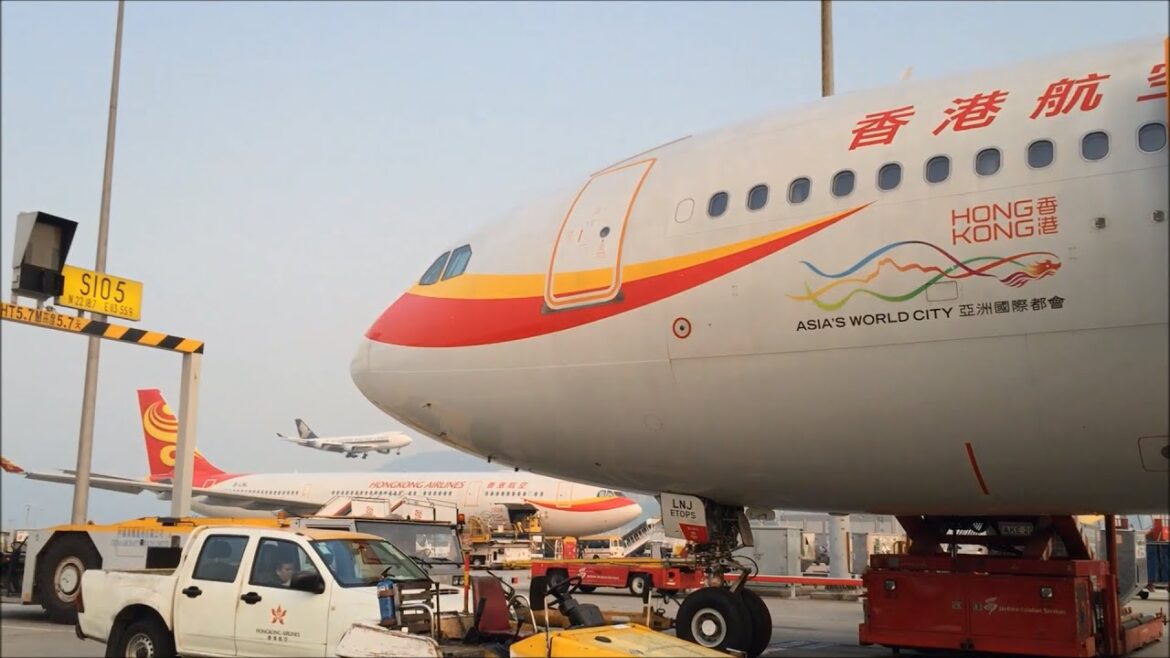Evening take off at HGK. Powered by Rolls Royce Trent 700-series engines (“The list price for a RR Trent 700-series engine is between 35.5 and 37.5 million US dollars”) Incredible technology! As of 2014, HKG is “the world’s busiest cargo gateway and one of the world’s busiest passenger airports.”
The Rolls-Royce Trent 700 is a three spool high bypass turbofan aircraft engine, developed from the RB211, and is the first variant of the family of Trent engines.
Design and development
Rolls-Royce claims that the Trent 700 has the lowest life cycle fuel burn, and is the quietest and cleanest engine available on the A330. Cathay Pacific is the largest operator, with 31 Trent 700-powered A330s. Rolls received orders for 140 of the type during the Paris Air Show in June 2007. The Trent 700 was the third engine to market on the A330, after GE and PW. According to the Rolls-Royce website as of November 2012 the engine had a 57% market share while since the introduction of the Trent 700EP variant in 2009 its market share has been over 70%.[4]
Applications
The Trent 700 family powers the Airbus A330. It comes in 2 thrust ratings, 67,500 lbf (300 kN) and 71,100 lbf (316 kN).[5] It first entered service on Cathay Pacific’s A330s in March 1995.
https://en.wikipedia.org/wiki/Rolls-Royce_Trent_700
Hong Kong International Airport (IATA: HKG, ICAO: VHHH) is the main airport in Hong Kong. It is located on the island of Chek Lap Kok, which largely comprises land reclaimed for the construction of the airport itself. The airport is also colloquially known as Chek Lap Kok Airport (赤鱲角機場), to distinguish it from its predecessor, the closed Kai Tak Airport.
The airport has been commercially operational since 1998, replacing the former Kai Tak Airport, and is an important regional trans-shipment centre, passenger hub and gateway for destinations in Mainland China (with 45 destinations) and the rest of Asia. The airport is the world’s busiest cargo gateway and one of the world’s busiest passenger airports.[4]
The Hong Kong International Airport is also home to one of the world’s largest passenger terminal buildings (the largest when opened in 1998). Hong Kong International Airport is one of the busiest airports in Asia. Operated by the Airport Authority Hong Kong 24 hours a day, the airport is the primary hub for Cathay Pacific (the flag carrier of Hong Kong), Dragonair, Hong Kong Airlines, Hong Kong Express Airways and Air Hong Kong (cargo carrier). The airport is one of the hubs of Oneworld alliance, and it is also one of the Asian-Pacific cargo hubs for UPS Airlines.[1] It is a focus city for many airlines, including China Airlines (Taiwan), and China Eastern Airlines. Singapore Airlines, Ethiopian Airlines, and Air India use Hong Kong as a stopover point for their flights.
HKIA is an important contributor to Hong Kong’s economy, with approximately 65,000 employees. More than 100 airlines operate flights from the airport to over 180 cities across the globe. In 2014, HKIA handled 63.3 million passengers,[4] making it the 10th busiest airport worldwide by passenger traffic.[5] It also surpassed Memphis International Airport to become the world’s busiest airport by cargo traffic.[6]
https://en.wikipedia.org/wiki/Hong_Kong_International_Airport
Hong Kong Airlines Ltd (Chinese: 香港航空公司), IATA: HX is a Hong Kong-based airline, with its corporate headquarters in Tung Chung and its main hub at Hong Kong International Airport. It was established in 2006.
Based in Hong Kong, Hong Kong Airlines’ network currently covers almost 30 cities regionally, including Beijing, Shanghai, Sanya, Bangkok, Bali, and Okinawa. The current passenger fleet has 25 aircraft, which includes three Airbus A330-300s, nine Airbus A330-200s and eight A320s, with up-to-date inflight entertainment system and an average age of around 3 years as of February 2015. The cargo fleet consists of five Airbus A330-200Fs.[2]
https://en.wikipedia.org/wiki/Hong_Kong_Airlines
http://www.flightradar24.com/data/airplanes/b-lnj/
https://planefinder.net/data/aircraft/B-LNJ

